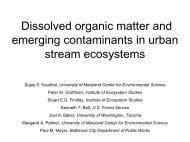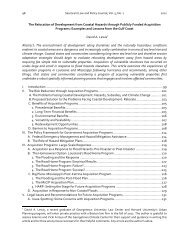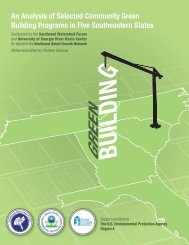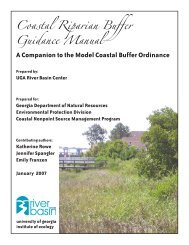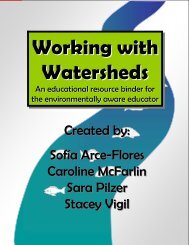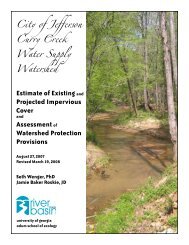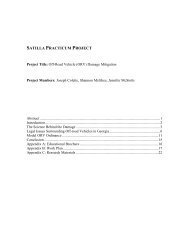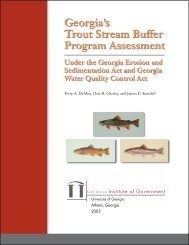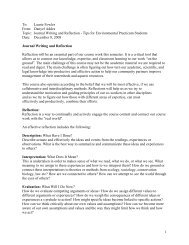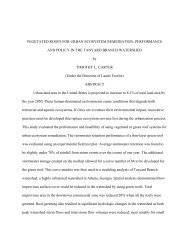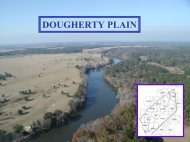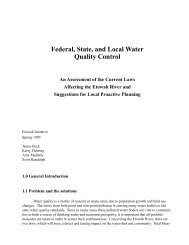1 Bibliographic Review of Sources Relevant to Development of Draft ...
1 Bibliographic Review of Sources Relevant to Development of Draft ...
1 Bibliographic Review of Sources Relevant to Development of Draft ...
Create successful ePaper yourself
Turn your PDF publications into a flip-book with our unique Google optimized e-Paper software.
Savannah River Annotated Bibliography: January 2003<br />
Krueger, W.H., and K. Oliveira. 1999. Evidence for environmental sex determination in<br />
the American eel, Anguilla rostrata. Environmental Biology <strong>of</strong> Fishes. 55, 381-389.<br />
Field studies and experiments on the American eel Anguilla rostrata indicated<br />
environmental sex determination (ESD). High population densities result in the high<br />
proportion <strong>of</strong> males; the converse is true, as well. ESD may be adaptively<br />
significant and an explanation for this is provided.<br />
Martin, M.H. 1995. The effects <strong>of</strong> temperature, river flow, and tidal cycles on the onset<br />
<strong>of</strong> glass eel and elver migration in<strong>to</strong> fresh water in the American eel. Journal <strong>of</strong> Fish<br />
Biology. 46, 891-902.<br />
The onset <strong>of</strong> Anguilla rostrata elver migration in<strong>to</strong> freshwater was examined and<br />
related <strong>to</strong> environmental fac<strong>to</strong>rs in a Rhode Island River. Increased river<br />
temperatures and reduced flow increased elver migration early in the season<br />
(March), but tidal stage appeared <strong>to</strong> be more important in May-June. Thermal or<br />
oldfac<strong>to</strong>ry cues that accompanied the increase in water flow may have played a role<br />
in elver migration. Other studies suggest that elvers prefer higher temperatures in<br />
long-term experiments and selective tidal stream transport.<br />
Striped Bass<br />
Bain, K.B. and J.L. Bain. 1982. Habitat suitability index models: Coastal s<strong>to</strong>cks <strong>of</strong><br />
striped bass. U.S. Fish and Wildlife Service, Office <strong>of</strong> Biological Services,<br />
Washing<strong>to</strong>n, D.C. FWS/OBS-82/10.1. 29 pp.<br />
This HSI model may be useful for developing flow recommendations as several <strong>of</strong><br />
the suitability index variables measured in the model pertain <strong>to</strong> river flow rates. The<br />
model was located at the following web address:<br />
http://www.nwrc.usgs.gov/wdb/pub/hsi/hsi-001.pdf<br />
Dudley, R.G., A.W. Mullis, and J.W. Terrell. 1977. Movement <strong>of</strong> Adult Striped Bass<br />
(Morone saxatilis) in the Savannah River, Ga. Transactions <strong>of</strong> the American<br />
Fisheries Society. 106: 314-322.<br />
After spawning in March-May, striped bass move as far as 301 km upstream and<br />
remained there throughout the summer (Dudley et al., 1977).<br />
Dudley, R.G., and K.N. Black. 1978. Distribution <strong>of</strong> striped bass eggs and larvae in the<br />
Savannah River estuary. Proceedings <strong>of</strong> the Annual Conference <strong>of</strong> the Southeastern<br />
Association <strong>of</strong> Fish and Wildlife Agencies. 32: 561-570.<br />
Dudley, R.G., and K.N. Black. 1979. Effects <strong>of</strong> the Savannah River Tidegate on Striped<br />
Bass Eggs and Larvae. Final Report <strong>to</strong> the U.S. Army Corps <strong>of</strong> Engineers on<br />
contract DACW21-78-C-0073, 46 pp.<br />
Jennings, C. A., B.J. Hess, and C. Jackson. 1999. Use <strong>of</strong> Cool-Water Springs as<br />
Thermal Refuge by Striped Bass in the Ogeechee River, Georgia. Georgia Journal<br />
<strong>of</strong> Science. 57 (2): 123-130.<br />
This study was a two-year telemetry study conducted <strong>to</strong> determine whether or not<br />
summertime cool water refuge area was limiting <strong>to</strong> striped bass in the Ogeechee<br />
River, Ga. The conclusion was that Ogeechee River striped bass were not limited <strong>to</strong><br />
upstream cool water springs and may meet most <strong>of</strong> their thermal requirements in the<br />
estuary or the mainstem <strong>of</strong> the Ogeechee River.<br />
44




